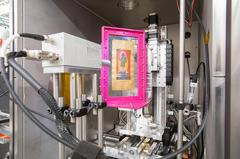URL: https://www.desy.de/news/news_search/index_eng.html
Breadcrumb Navigation
DESY News: Examining written artefacts with x-rays
News
News from the DESY research centre
Examining written artefacts with x-rays
Within a new cooperation between the Cluster of Excellence ‘Understanding Written Artefacts’ (UWA) at Universität Hamburg and the German Electron Synchrotron DESY, scientists from Hamburg are now investigating historical written artefacts at the X-ray radiation source PETRA III. The prominent advantage of X-ray investigations is that the artefacts can be examined without any destruction. As far as the examination method allows, no special sample preparation is required - the precious and unique objects thus remain intact.

A tsakali during the experiment, Picture: DESY, Marta mayer
Currently, there are two pilot studies underway. The first study deals with Mesopotamian cuneiform tablets. These millennia-old artefacts are an essential source for understanding this ancient, advanced civilization. However, many tablets that cannot be dated and originated are of limited value for research. DESY and UWA are investigating 36 objects from the Museum für Kunst und Gewerbe (MKG) and the Hamburg State and University Library (SUB) collections to understand the context of the origin of a tablet by analyzing the nature of the clay. The powder diffraction method was chosen for the non-destructive and basic material characterization of this investigation. In this method, all mineral grains are detected by the X-ray beam in a local area, and these thus contribute to a characteristic diffraction pattern for a specific part of the clay tablet. The diffraction pattern consists of individual diffraction reflections for each contained mineral and gives atomic-level information about the crystalline structure. With suitable software, the mineral components can be analyzed, and thus an insight into the atomic structure - as well as the quantitative composition - of these minerals can be obtained.
The second study revolves around 65 tsakalis - Tibetan written artefacts that belong to the Bon religion from the 15th to the 17th centuries. These are cards with spiritual drawings and texts that were used for meditation and initiation rites. The cards were made by a master, especially for his students. This study aims to find out whether the non-destructive material characterization methods Small-Angle X-ray Scattering (SAXS) and Wide-Angle X-ray Scattering (WAXS) at the SAXSMAT beamline at DESY can provide quantitative information about the materials used, and their processing. For the measurements of the tsakalis, a special sample holder was developed to examine the sensitive manuscripts with the X-ray beam. The SAXS measurements provide information about the paper structure on the nanometer scale, in particular about the size distribution of the cellulose fibers and their orientation. This information will allow drawing conclusions about the manufacturing process of the paper used for the tsakalis, and, in the best case, answer the question of whether all tsakalis were manufactured at the same time and place. The WAXS measurements taken at the same time will provide information about the pigments that are used for the drawings and texts on the manuscript, similar to the powder diffraction measurements on the clay tablets.
In addition, various types of paper from different regions and centuries will be studied with these methods to create a long-term database with the measured X-ray scattering profiles and their known information (production period, provenance, production method, etc.). Machine learning should then make it possible to quickly assign manuscripts of unknown origin to a region and a production period.
This interdisciplinary collaboration between DESY and UWA will not be limited to individual measurements and projects. Their first joint success was the development of a molecular computer tomography for measuring Mesopotamian clay tablets, and now the measurements will follow from PETRA III. This collaboration aims to jointly improve the methods for examining a wide variety of written artefacts in such a way that the knowledge gained from the data at the molecular level leads to faster and better answers to many questions, for example how and where paper documents such as the tsakalis were once produced.



